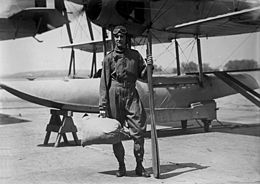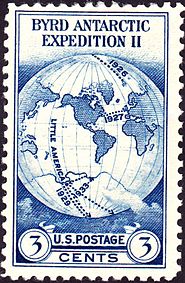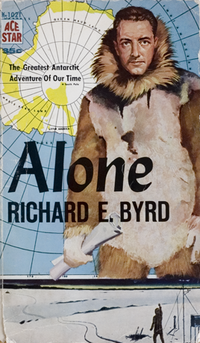- Richard E. Byrd
-
Richard Evelyn Byrd 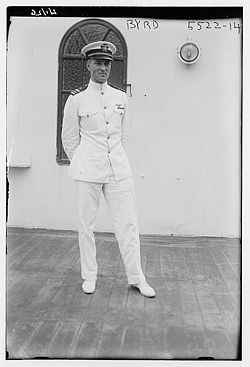
Born 25 October 1888
Winchester, VirginiaDied 11 March 1957 (aged 68)
Boston, MassachusettsPlace of burial Arlington National Cemetery Allegiance United States of America Service/branch United States Navy Years of service 1912–1927
1940–1947Rank Rear Admiral Battles/wars World War I
World War IIAwards Medal of Honor
Navy Cross
Navy Distinguished Service Medal
Distinguished Flying Cross
Legion of MeritRear Admiral Richard Evelyn Byrd, Jr., USN (25 October 1888 – 11 March 1957) was a naval officer who specialized in feats of exploration. He was a pioneering American aviator, polar explorer, and organizer of polar logistics. Aircraft flights, in which he served as a navigator and expedition leader, crossed the Atlantic Ocean, a segment of the Arctic Ocean, and a segment of the Antarctic Plateau. Byrd claimed that his expeditions had been the first to reach the North Pole and the South Pole by air. His South Pole claim is generally supported by a consensus of those who have examined the evidence. Byrd was a recipient of the Medal of Honor, the highest honor for heroism given by the United States.
Ancestry
He was a descendant of one of the First Families of Virginia. His ancestors include planter John Rolfe and his wife Pocahontas, William Byrd II of Westover Plantation, who established Richmond, and Robert "King" Carter, a colonial governor. He was the brother of Virginia Governor and U.S. Senator Harry F. Byrd, a dominant figure in Virginia Democratic Party between the 1920s and 1960s; their father served as Speaker of the Virginia House of Delegates for a time.
Family
Admiral Byrd was married (20 January 1915) to the former Marie Donaldson Ames [he named a region of Antarctic land he discovered “Marie Byrd Land”] and had four children:
- Richard Evelyn Jr., (grandchildren Richard Byrd, Leverett S. Byrd, Ames Byrd, and Harry Flood Byrd II)
- Evelyn Bolling Byrd Clarke (grandchildren Evelyn Byrd Clarke, Marie Ames Clarke, Eleanor Clarke, and Richard Byrd Clarke)
- Catherine Agnes Byrd Breyer (grandchildren Robert Byrd Breyer and Katherine Ames Breyer)
- Helen Byrd Stabler (grandchildren David Stabler and Ann Blanchard Stabler)
Byrd attended the Virginia Military Institute before financial circumstances inspired his transfer to the United States Naval Academy in 1912. He learned to fly in World War I during his tour with the United States Navy. He developed a passion for flight, and pioneered many techniques for navigating airplanes over the open ocean including drift indicators and bubble sextants. His expertise in this area resulted in his appointment to plan the flight path for the U.S. Navy's 1919 transatlantic crossing. Of the three flying boats that attempted it, only Albert Read's NC-4 aircraft completed the trip, becoming the first ever transatlantic flight.[1]
1926 North Pole flight, and controversy
On 9 May 1926, Byrd and pilot Floyd Bennett attempted a flight over the North Pole in a Fokker F-VII Tri-motor called the Josephine Ford. This flight went from Spitsbergen (Svalbard) and back to its take-off airfield. Byrd claimed to have reached the Pole. This trip earned Byrd widespread acclaim, including being awarded the Medal of Honor and enabled him to secure funding for subsequent attempts to fly over the South Pole.
From 1926 until 1996, there were doubts, defenses, and heated controversy about whether or not Byrd actually reached the North Pole. In 1958 Norwegian-American aviator and explorer Bernt Balchen cast doubt on Byrd's claim on the basis of his extensive personal knowledge of the airplane's speed. In 1971 Balchen speculated that Byrd had simply circled aimlessly while out of sight of land.[2]
The 1996 release of Byrd's diary of the 9 May 1926 flight revealed erased (but still legible) sextant sights that sharply differ with Byrd's later 22 June typewritten official report to the National Geographic Society. Byrd took a sextant reading of the Sun at 7:07:10 GCT. His erased diary record shows the apparent (observed) solar altitude to have been 19°25'30", while his later official typescript reports the same 7:07:10 apparent solar altitude to have been 18°18'18".[3] On the basis of this and other data in the diary, Dennis Rawlins concluded that Byrd steered accurately, and flew about 80% of the distance to the Pole before turning back because of an engine oil leak, but later falsified his official report to support his claim of reaching the pole.[4] Others disagree with Rawlins. In 1998, Colonel William Molett, an experienced navigator published “Due north?” Molett maintained that Rawlins had put too much significance in erased navigational calculations which can be explained by any number of other reasons, including favorable windspeeds as well as simple human error due to lack of sleep and stress.[5]
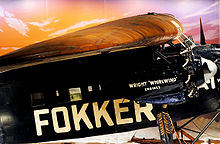 The Fokker FVIIa/3M – "Josephine Ford", on display at The Henry Ford Museum
The Fokker FVIIa/3M – "Josephine Ford", on display at The Henry Ford Museum
Accepting that the conflicting data in the typed report's flight times indeed require both northward and southward groundspeeds greater than the flight's 85 mph airspeed, a remaining Byrd defender posits a westerly-moving anti-cyclone that tailwind-boosted Byrd's groundspeed on both outward and inward legs, allowing the distance claimed to be covered in the time claimed. (The theory is based on rejecting handwritten sextant data in favor of typewritten alleged dead-reckoning data.)[6] This suggestion has been refuted by Dennis Rawlins[7] who adds[8] that the sextant data in the long unavailable original official typewritten report are all expressed to 1", a precision not possible on Navy sextants of 1926 and not the precision of the sextant data in Byrd's diary for 1925 or the 1926 flight, which was normal (half or quarter of a minute of arc). Some sources claim that Floyd Bennett and Byrd later revealed, in private conversations, that they did not reach the pole. One source claims that Floyd Bennett later told a fellow pilot that they did not reach the pole.[9] It is also claimed that Byrd confessed his failure to reach the North Pole during a long walk with Dr. Isaiah Bowman in 1930.[10]
If Byrd and Bennett didn't reach the North Pole, it is extremely likely that the first flight over the Pole was the flight of the airship Norge in May 1926 with its crew of Roald Amundsen, Umberto Nobile, Oscar Wisting, and others. This flight went from Spitsbergen (Svalbard) to Alaska nonstop, so there is little doubt that they went over the North Pole. Amundsen and Wisting had both been members of the first expedition to the South Pole, December 1911.
Trans-Atlantic flight, 1927
In 1927 non stop flights across the Atlantic Ocean had not yet been accomplished. Byrd announced he had the backing of the 'American Trans-Oceanic Company, Inc.', which was established in 1914 by Rodman Wanamaker with the purpose of building the aircraft to complete the harrowing journey. Byrd was one of several aviators who attempted to win the Orteig Prize in 1927 for making the first nonstop flight between the United States and France. His flight was sponsored by department-store magnate Rodman Wanamaker, an early visionary of Trans-Atlantic commercial flight.
Once again Byrd named Floyd Bennett as his chief pilot, with support from Bernt Balchen, Bert Acosta, and George Noville. During a practice takeoff with Tony Fokker at the controls and Bennett in the co-pilots seat, the Fokker Trimotor airplane, America, crashed, severely injuring Bennett and slightly injuring Byrd. As the plane was being repaired, Charles Lindbergh won the prize. But Byrd continued with his quest, naming Balchen to replace Bennett as chief pilot. Byrd, Balchen, Acosta, and Noville flew from Roosevelt Field East Garden City, New York on 29 June 1927. Arriving over France, cloud cover prevented a landing in Paris; they returned to the coast of Normandy, crash-landing near the beach at Ver-sur-Mer without fatalities on 1 July 1927.[11]
After he returned to the US, Byrd wrote an article for the August 1927 edition of Popular Science Monthly in which he predicted that while specially modified aircraft with one to three crewmen would fly the Atlantic non-stop, it would be another 20 year before it would be realized on a commercial scale. [12]
First Antarctic expedition, 1928–1930
In 1928, Admiral Byrd began his first expedition to the Antarctic involving two ships, and three airplanes: Byrd's Flagship was The City of New York; a Ford Trimotor called the Floyd Bennett (named after the recently deceased pilot of Byrd's previous expeditions); a Fairchild FC-2W2, NX8006, built 1928, named "Stars And Stripes" (now displayed at the Virginia Aviation Museum, on loan from the National Air and Space Museum); and a Fokker Universal monoplane called the Virginia (Byrd's birth state). A base camp named "Little America" was constructed on the Ross Ice Shelf and scientific expeditions by snowshoe, dog-sled, snowmobile, and airplane began. Photographic expeditions and geological surveys were undertaken for the duration of that summer, and constant radio communications were maintained with the outside world. After their first winter, their expeditions were resumed, and on 28 November 1929, the famous flight to the South Pole and back was launched. Byrd, along with pilot Bernt Balchen, co-pilot/radioman Harold June, and photographer Ashley McKinley, flew the Ford Trimotor to the South Pole and back in 18 hours, 41 minutes. They had difficulty gaining enough altitude, and they had to dump empty gas tanks, as well as their emergency supplies, in order to achieve the altitude of the Polar Plateau. However, the flight was successful, and it entered Byrd into the history books. After a further summer of exploration, the expedition returned to North America on 18 June 1930. A 19 year-old American Boy Scout, Paul Allman Siple, was chosen to accompany the expedition. Unlike the 1926 flight, this expedition was honored with the gold medal of the American Geographical Society. This was also seen in the 1930 film With Byrd at the South Pole in which it covered his trip there.
Byrd, by then an internationally recognized, pioneering American polar explorer and aviator, served for a time as Honorary National President (1931–1935) of Pi Gamma Mu, the international honor society in the social sciences. In 1928, he carried the Society's flag during a historic expedition to the Antarctic to dramatize the spirit of adventure into the unknown, characterizing both the natural and social sciences.[13][14]
Byrd's later Antarctic expeditions
Byrd undertook four more expeditions to Antarctica from 1933–35, 1939–40, 1946–47 and 1955–56.
As a senior officer in the United States Navy, Byrd, performed national defense service during World War II (1941–45), mostly as a consultant to the U.S.N. high commanders.
On his second expedition, in 1934, Byrd spent five winter months alone operating a meteorological station, Advance Base, from which he narrowly escaped with his life after suffering carbon monoxide poisoning from a poorly ventilated stove. Unusual radio transmissions from Byrd finally began to alarm the men at the base camp, who then attempted to go to Advance Base. The first two trips were failures due to darkness, snow, and mechanical troubles. Finally, Dr. Thomas Poulter, E.J. Demas, and Amory Waite arrived at Advanced Base, where they found Byrd in poor physical health. The men remained at Advanced Base until 12 October when an airplane from the base camp picked up Dr. Poulter and Byrd. The rest of the men returned to base camp with the tractor. This expedition is described by Byrd in his autobiography Alone. It is also commemorated in a U.S. postage stamp issued at the time, and a considerable amount of mail using it was sent from Byrd's base at Little America, which was powered by a Jacobs Wind 2.5 kW. Later a souvenir sheet was also issued.[15]
In late 1938, Byrd visited Hamburg and was invited to participate in the 1938/1939 German "Neuschwabenland" Antarctic Expedition, but declined.
Byrd's third expedition was his first one on which he had the official backing of the U.S. government. The project included extensive studies of geology, biology, meteorology and exploration. Within a few months, in March 1940, Byrd was recalled to active duty in the Office of the Chief of Naval Operations. The expedition continued in Antarctica without him. From 1942 to 1945 he headed important missions to the Pacific, including surveys of remote islands for airfields. On one assignment he visited the fighting front in Europe. He was repeatedly cited for meritorious service and was present at the Japanese surrender.
The fourth culminating expedition, Operation Highjump, is the largest Antarctic expedition to date. In 1946, US Navy Secretary James Forrestal assembled a huge amphibious naval force for an Antarctic Expedition expected to last six to eight months. Besides the flagship USS Mount Olympus and the aircraft carrier USS Philippine Sea, there were thirteen US Navy support ships, six helicopters, six flying boats, two seaplane tenders and fifteen other aircraft. The total number of personnel involved was over 4,000. The armada arrived in the Ross Sea on 31 December 1946, and made aerial explorations of an area half the size of the United States, recording ten new mountain ranges. The major area covered was the eastern coastline of Antarctica from 150 degrees east to the Greenwich meridian.
As part of the multinational collaboration for the International Geophysical Year (IGY) 1957–58, Byrd commanded the U.S. Navy Operation Deep Freeze I in 1955–56, which established permanent Antarctic bases at McMurdo Sound, the Bay of Whales, and the South Pole.
Death
Byrd died in his sleep on 11 March 1957 of a heart ailment at his Brimmer Street home in Boston.[16][17] He was buried in Arlington National Cemetery.[16]
Awards, decorations, honors
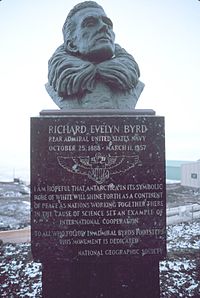 Bust of Richard E. Byrd by Felix de Weldon at McMurdo Station.
Bust of Richard E. Byrd by Felix de Weldon at McMurdo Station.
By the time he died, he had amassed twenty-two citations and special commendations, nine of which were for bravery and two for extraordinary heroism in saving the lives of others. In addition, he received the Medal of Honor, the Lifesaving Medal, the Navy Distinguished Service Medal, the Distinguished Flying Cross, the Navy Cross, and had three ticker-tape parades. He preferred to dwell on the substance of his global adventures, and the stories of those that had gone awry as lessons learned.
In 1927, the Boy Scouts of America made Byrd an Honorary Scout, a new category of Scout created that same year. This distinction was given to "American citizens whose achievements in outdoor activity, exploration and worthwhile adventure are of such an exceptional character as to capture the imagination of boys...". The other eighteen who were awarded this distinction were: Roy Chapman Andrews; Robert Bartlett; Frederick Russell Burnham; George Kruck Cherrie; James L. Clark; Merian C. Cooper; Lincoln Ellsworth; Louis Agassiz Fuertes; George Bird Grinnell; Charles A. Lindbergh; Donald Baxter MacMillan; Clifford H. Pope; George P. Putnam; Kermit Roosevelt; Carl Rungius; Stewart Edward White; Orville Wright.[18]
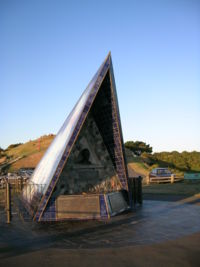 Byrd Memorial on Mount Victoria, Wellington, New Zealand
Byrd Memorial on Mount Victoria, Wellington, New Zealand
Also in 1927, the City of Richmond dedicated the Richard Evelyn Byrd Flying Field, now Richmond International Airport, in Henrico County, Virginia. Byrd's Fairchild FC-2W2, NX8006, "Stars And Stripes" is on display at the Virginia Aviation Museum located on the north side of the airport, on loan from the National Air and Space Museum in Washington, D.C.
Lunar crater Byrd is named after him, as was the United States Navy dry cargo ship USNS Richard E. Byrd (T-AKE-4) and the now decommissioned Charles F. Adams-class guided missile destroyer USS Richard E. Byrd (DDG-23)
In Glen Rock, New Jersey Richard E. Byrd School was dedicated in 1931. The Polar Research Center at Ohio State University, Columbus, Ohio was named in honor of Admiral Byrd in 1984. In 1958 the Richard Byrd library, part of the Fairfax County Public Library system opened in Springfield, Virginia. Admiral Richard E. Byrd Middle School, located in Frederick County, Virginia, was opened in 2005, and is decorated with pictures and letters from Byrd's life and career.
Memorials to Byrd can be found in two cities in New Zealand (Wellington and Dunedin). Byrd used New Zealand as his departure point for several of his Antarctic flights.
The fiftieth anniversary of Byrd's first flight over the South Pole was commemorated in a set of two postage stamps by Australian Antarctic Territory in 1979.
The long-range shortwave voice transmissions from Byrd's Antarctic expedition in 1934 was named an IEEE Milestone in 2001.[19]
Medal of Honor citation
Rank and organization: Commander, United States Navy. Born: 25 October 1888, Winchester, Va. Appointed from: Virginia. Other Navy awards: Navy Cross, Distinguished Service Medal, Legion of Merit with gold star, Distinguished Flying Cross.
Citation:
For distinguishing himself conspicuously by courage and intrepidity at the risk of his life, in demonstrating that it is possible for aircraft to travel in continuous flight from a now inhabited portion of the earth over the North Pole and return.
Partial List of Medals Awarded to Rear Admiral Richard E. Byrd, USN:
- Medal of Honor (1926) (Rare Tiffany Cross version)
- Navy Cross
- Navy Distinguished Service Medal with Gold Star
- Legion of Merit with Gold Star
- Distinguished Flying Cross (1926)
- Navy Commendation Medal
- Lifesaving Medal (1914)
- Victory Medal (1918)
- Byrd Antarctic Expedition Medal, issued in gold (1928–1930)
- 2nd Byrd Antarctic Expedition Medal (1933–1935)
- United States Antarctic Expedition Medal (1939–1941)
- American Campaign Medal (1943)
- Asiatic Pacific Campaign Medal (1942)
- European-African-Middle Eastern Campaign Medal
- World War Two Victory Medal (1945)
- Antarctica Service Medal, posthumously awarded (1960)
See also
- List of Antarctic expeditions
- List of Medal of Honor recipients
- Laurence McKinley Gould
- Mount Iphigene
Notes
- ^ Century of Flight: The Atlantic Challenge
- ^ Montague, Richard (1971). Oceans, Poles, and Airmen. Random House Publishing. pp. 48.
- ^ Goerler, Raimund E. (1998). To the Pole: The Diary and Notebook of Richard E. Byrd, 1925–1927. Ohio State University Press. pp. 84–85, compare to p 154.
- ^ New York Times,9 May 1996, page 1; Rawlins, Dennis (January 2000). "Byrd's Heroic North Pole Failure". Polar Record (Scott Polar Research Institute, University of Cambridge) 36: 25–50; see pages 33–34. Rawlins, Dennis (January 2000). "Byrd’s Heroic 1926 Flight & Its Faked Last Leg" (PDF). DIO: the International Journal of Scientific History 10: 2–106; see page 40. http://www.dioi.org/vols/wa0.pdf. Retrieved 13 July 2007.
- ^ The North Pole Flight of Richard E. Byrd: An Overview of the Controversy, Ohio State University
- ^ Portney, Joseph (2000). "The Polar Flap: Byrd's Flight Confirmed". Litton Systems, Inc.. http://www.navworld.com/navcerebrations/polar_flap.htm. See also Portney, Joseph (1973). "The Polar Flap: Byrd's Flight Confirmed". J.Inst.Nav 20 (3): 208–218. and Portney, Joseph (1992). "History of Aerial Polar Navigation". J.Inst.Nav 39 (2): 255–264.
- ^ Rawlins, Dennis (January 2000). "Byrd’s Heroic 1926 Flight & Its Faked Last Leg" (PDF). DIO: the International Journal of Scientific History 10: 2–106; see pages 69–76; also pages 54, 84–88, 99, 105. http://www.dioi.org/vols/wa0.pdf. Retrieved 13 July 2007.
- ^ Ibid pp.39–41
- ^ Nash, Simon (2005). The Last Explorer. Hodder. pp. 149.
- ^ Fairbanks (2002). Polar Extremism: the world of Lincoln Ellsworth. University of Alaska Press. Chapter 4.
- ^ Check-Six.com – The Ditching of the "America"
- ^ "Why We May Wait 20 Years for Ocean Airliners" Popular Science, August 1927, p. 9
- ^ "Richard E. Byrd 1888–1957". South-Pole.com. http://www.south-pole.com/p0000107.htm. Retrieved 8 May 2011.
- ^ "Byrd Antarctic Expedition III, 1939–41". South-Pole.com. http://www.south-pole.com/p0000109.htm. Retrieved 8 May 2011.
- ^ Paul Skowron, "A Philatelic Introduction to B.A.E. II: The Stamps"
- ^ a b Admiral Richard E. Byrd-Arlington National Cemetery
- ^ "Admiral Byrd Dies at 68. Made 5 Polar Expeditions. Admiral Flew Over Both Poles and Helped Establish Antarctic as a Continent. Byrd Dies at 68. Polar Explorer. 5 Arctic and Antarctic Trips Provided Groundwork for U.S. Defense Concepts Frigid Testing Ground First Trip in 1928–1929. Born in Virginia. Polar Flight Eclipsed Work Under Federal Auspices.". New York Times. 9 Oct 1988. http://select.nytimes.com/gst/abstract.html?res=F60B14FC3D5D167B93C0A81788D85F438585F9&scp=7&sq=Richard+Evelyn+Byrd&st=p. Retrieved 23 May 2008. "Rear Admiral Richard E. Byrd, U.S.N., retired, the first man to fly over the North and South Poles, died in his sleep tonight at his Brimmer Street home. He was 68 years old."
- ^ "Around the World". Time (magazine). 29 August 1927. http://www.time.com/time/magazine/article/0,9171,723029,00.html. Retrieved 24 October 2007.
- ^ "Milestones:Long-Range Shortwave Voice Transmissions from Byrd's Antarctic Expedition, 1934". IEEE Global History Network. IEEE. http://www.ieeeghn.org/wiki/index.php/Milestones:Long-Range_Shortwave_Voice_Transmissions_from_Byrd%27s_Antarctic_Expedition,_1934. Retrieved 3 August 2011.
References
- Time (magazine); Monday, 8 November 1926. Born. To Mrs. Marie Ames Byrd, of Winchester, Virginia, and Boston, a daughter. Mrs. Byrd is the wife of Lieut. Commander Richard Evelyn Byrd, U.S.N., who flew to the North Pole and back from Spitsbergen last spring. Lieutenant Byrd's brother, Harry F. Byrd, is Governor of Virginia.
- Rodgers, Eugene (March 1997). Beyond the Barrier: The Story of Byrd's First Expedition to Antarctica. United States Naval Institute. ISBN 978-1557507136.
External links
- "The North Pole Flight of Richard E. Byrd: An Overview of the Controversy". Polar Archival Program, Ohio State University. 2007. http://library.osu.edu/sites/archives/polar/flight/controversy.php. Retrieved 14 July 2007.
- "70South – information on Richard E. Byrd". 25 October 2007. http://www.70south.com/resources/history/explorers/byrd.
- "Richard E. Byrd's 1926 Flight Towards the North Pole" (PDF). 25 October 2007. http://www.dioi.org/vols/wa0.pdf.
- "To the Pole: The Diary and Notebook of Richard E. Byrd, 1925–1927". 15 February 2008. http://www.ohiostatepress.org/index.htm?/books/book%20pages/goerler%20to.htm.
- "The Flight of the 'America' – 1927". 25 October 2007. http://www.check-six.com/Crash_Sites/America-NX206.htm.
- "Richard E. Byrd 1888–1957". 25 October 2007. http://www.south-pole.com/p0000107.htm.
- "Did Richard Byrd get to the North Pole in 1926?". 25 October 2007. http://home.acadia.net/userpages/kikut/BBMainText.htm.
- "A navigation expert's look at how Byrd's claim is one possible interpretation of his diary.". 25 October 2007. http://www.navworld.com/navcerebrations/polar_flap.htm.
- "The History Of The Sailing Vessel City of New York, Admiral Byrd's Exploration Ship, Skippered By Captain Charles J. McGuinness". Tim McGuinness, PhD. 25 October 2007. http://sailoroffortune.com/city_of_new_york.htm.
- "The Byrd Polar Research Center at Ohio State University". 25 October 2007. http://www-bprc.mps.ohio-state.edu/.
- "Richard E. Byrd". Claim to Fame: Medal of Honor recipients. Find a Grave. http://www.findagrave.com/cgi-bin/fg.cgi?page=gr&GRid=156. Retrieved 25 October 2007.
- "At the bottom of the World", Popular Mechanics, August 1930, pp. 225-241
Aviation Hall of Fame of New Jersey 1973 Amelia Earhart / Anne Morrow Lindbergh / Floyd Bennett / Clarence Duncan Chamberlin / Clyde Pangborn / Wittemann brothers · 1974 Anthony Fokker · 1975 Juan Terry Trippe · 1976 Bert Blanchard Acosta / Arthur Godfrey · 1980 Edwin Eugene "Buzz" Aldrin, Jr. / Boland brothers / Charles Emery Rosendahl / Gill Robb Wilson · 1981 Robert Nietzel Buck · 1982 Walter M. "Wally" Schirra · 1984 Robert J. Collier · 1985 Malcolm S. Forbes · 1987 Kathryn Dwyer Sullivan / Oliver George Simmons · 1988 William Halsey, Jr. / Frederick Walker Castle · 1989 Charles J. Fletcher · 1993 Jean-Pierre Blanchard · 1996 Vincent Justus Burnelli / Kenneth A. Walsh · 1998 Richard E. Byrd · 1999 Terry Jonathan Hart · 2002 Oliver Colin LeBoutillier
Antarctica Main articles - Antarctic
- History
- Geography
- Climate
- Expeditions
- Research stations
- Field camps
- Territorial claims
- Antarctic Treaty System
- Telecommunications
- Demographics
- Economy
- Tourism
- Transport
- Military activity in the Antarctic
Geographic regions - Antarctic Peninsula
- East Antarctica
- West Antarctica
- Extreme points of the Antarctic
- List of Antarctic and subantarctic islands
- Antarctica ecozone
Waterways Famous explorers - Ernest Shackleton
- James Clark Ross
- Richard E. Byrd
- Roald Amundsen
- Douglas Mawson
- Robert Falcon Scott
- more...
Categories:- 1888 births
- 1957 deaths
- American aviators
- American Episcopalians
- American people of English descent
- Burials at Arlington National Cemetery
- Congressional Gold Medal recipients
- Explorers of Antarctica
- United States and the Antarctic
- Byrd family of Virginia
- United States naval aviators
- Recipients of the Navy Cross
- Navy Medal of Honor recipients
- Oceanographers
- Recipients of the Distinguished Flying Cross (United States)
- Recipients of the Legion of Merit
- United States Naval Academy alumni
- United States Navy admirals
- National Aviation Hall of Fame inductees
- University of Virginia
- Virginia Military Institute alumni
- People from Winchester, Virginia
- Discovery and invention controversies
- American polar explorers
- 20th-century explorers
- Recipients of the Distinguished Service Medal (United States)
- University of Virginia alumni
- American Polar Society honorary members
Wikimedia Foundation. 2010.

